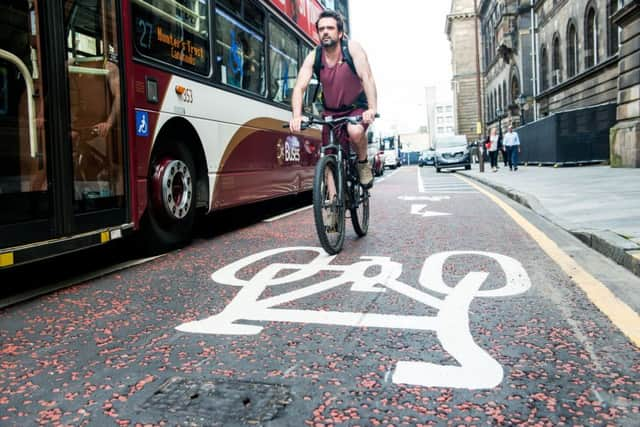Alastair Dalton: We need genuinely cyclable cities by reassigning road space


If that also involves whizzing past vehicles at a standstill on an congested road next door, so much the better for your choice of transport.
I also like the look of rural off-road sections of the national cycle network in Scotland, 95 per cent of which has just been officially judged as being in a good or very good condition.
Advertisement
Hide AdAdvertisement
Hide AdViewed from the train on the Edinburgh-Glasgow route via Bathgate and Airdrie, you can follow the still pristine-looking cycle path which was rebuilt eight years ago when the line was re-opened.
Other stretches of the network, such as between Oban and Fort William, look even more alluring.
Unfortunately, the picture is the opposite on road sections of the network, with the official survey by cycling and walking body Sustrans finding 80 per cent of them in poor condition.
That’s borne out by my own experience, with other cycle lanes in such a bad state they deter riders venturing on to them.
Too often such lanes remain potholed while the rest of the road has been repaired or resurfaced, too narrow for cyclists to feel safe, and blocked by parked vehicles when no driver would dare park across a road.
Some cycle lanes start and then suddenly peter out, sometimes with a kerb built out across them. Signs and markings can be inconsistent and even contradictory, as to be of no help to cyclist or driver alike.
Advanced stop lines at traffic lights, a crucial safety feature for riders turning right, frequently have worn-out markings which render them invisible even to motorists who know it’s illegal to stop on them.
Off-road paths may be in better nick, and there’s normally more space to ride round the potholes, but they are also plagued by other horrors such as tree roots distorting surfaces that make for an uncomfortably bumpy.
Advertisement
Hide AdAdvertisement
Hide AdIncomplete sections have become white elephants, such as the Bears Way between Glasgow and Milngavie, a segregated 1.5 mile route created by narrowing the busy A81 which requires cyclists to merge back into the traffic at either end.
Against a background of ministers imploring us to cycle more, it’s a distinctly uninviting prospect. From this evidence on the ground, cycling is demonstrably not being afforded its place in the transport pecking order that the policymakers have given it.
What’s needed is the creation of genuinely cyclable cities, a genuinely cyclable country. What we have are piecemeal sections of adequate cycle paths that require riders to run the gauntlet of hazards to get between them.
Cycle lanes need to be given enhanced status to reflect their importance in helping to literally pave the way for the significant increase in cycling the Scottish Government wants.
Its “vision” has been of 10 per cent of trips being made by bike by 2020 - a gigantic rise from around 2 per cent with little more than a year to achieve it.
Space for cycling on roads should be reserved and respected for the myriad benefits it brings, from reducing congestion and pollution to the health benefits for riders and the reduced toll on the NHS.
It’s not impossible. Russian city of Almetyevsk increased its cycling rate from zero to 7 per cent in 18 months. It’s all about who gets priority on the roads and how much we’re prepared to shift the balance.